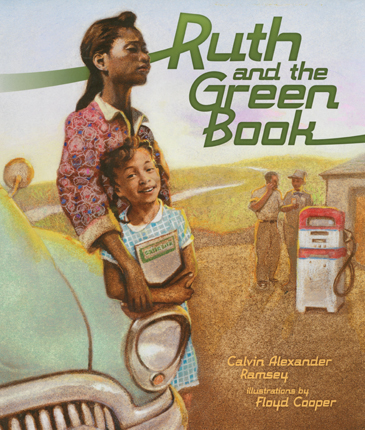| Ruth and The Green Book Author: Ramsey, Calvin A. | ||
| Price: $6.50 | ||
Summary:
When Ruth and her parents take a road trip from Chicago to Alabama, they rely on "The Negro Motorist Green Book" to find places that will serve them.
| Added Entry - Personal Name: | Strauss, Gwen |
| Illustrator: | Cooper, Floyd |
| Accelerated Reader Information: Interest Level: LG Reading Level: 4.60 Points: .5 Quiz: 138160 | Reading Counts Information: Interest Level: 3-5 Reading Level: 5.30 Points: 2.0 Quiz: 51577 | |
Common Core Standards
Grade 2 → Reading → RL Reading Literature → 2.RL Key Ideas & Details
Grade 2 → Reading → RL Reading Literature → 2.RL Range of Reading & Level of Text Complexity
Grade 2 → Reading → CCR College & Career Readiness Anchor Standards fo
Grade 3 → Reading → RL Literature → 3.RL Key Ideas & Details
Grade 3 → Reading → RL Literature → 3.RL Integration & Knowledge of Ideas
Grade 4 → Reading → RL Literature → 4.RL Key Ideas & Details
Grade 4 → Reading → RL Literature → 4.RL Range of Reading & Level of Text Complexity
Grade 4 → Reading → RL Literature → 4.RL Craft & Structure
Grade 4 → Reading → RL Literature → 4.RL Integration & Knowledge of Ideas
Grade 5 → Reading → RL Literature → 5.RL Key Ideas & Details
Grade 5 → Reading → RL Literature → 5.RL Integration & Knowledge of Ideas
Grade 5 → Reading → RL Literature → Texts Illustrating the Complexity, Quality, & Rang
Reviews:
Kirkus Reviews (10/15/10)
School Library Journal (+) (11/01/10)
Booklist (11/01/10)
The Bulletin of the Center for Children's Books (12/10)
Full Text Reviews:
Booklist - 11/01/2010 In this powerful picture book, Atlanta playwright Ramsey tells a 1950s story from “unknown pages in African American history.” Cooper’s glowing, unframed, sepia-toned artwork delivers a strong sense of the period from a child’s viewpoint. Driving with her parents from Chicago to Grandma’s house in Alabama, Ruth is excited until the family is refused access to the restroom at a service station. They face more bitter realities of segregation when they sleep in the car because they are turned away from hotels. The double-page spreads show the hurt, anger, and scariness of the “No Vacancy” signs, but words and images also capture moments of peace, as Ruth sings and feels safe with her loving parents as they drive across the country. Then they are welcomed at an Esso station, where they get a copy of the pamphlet called The Negro Motorist Green Book, which lists places where black people are welcome. A joyful reunion with Grandma brings the book to a warm close. With a long final note about The Green Book, this is a compelling addition to U.S. history offerings. - Copyright 2010 Booklist.
School Library Journal - 11/01/2010 Gr 1–4—Ruth's father just bought a beautiful new 1952 Buick, making it a big day for this African-American family. They are going from Chicago to Alabama to visit Grandma. Ruth is very excited to be traveling, but the family encounters "whites only" restrooms, hotels, and restaurants along the way. It's very discouraging and sometimes scary, but they learn that some friendly faces may be found at local Esso stations, which are among the few franchises open to black businessmen. At a station near the Georgia border, they are introduced to Victor H. Green's The Negro Motorist Green Book, an early AAA guidebook of sorts that listed establishments or homes that would serve African Americans—be it for general services, housing, or meals. Ruth eventually becomes the Green Book specialist in the family, helping to guide them to an auto-repair shop or an inn that would welcome them. But, the best part of the trip is finally arriving at Grandma's, as illustrated by the loving expressions on all faces. A one-page concluding summary discusses the importance of The Green Book, which was in use from 1936–1964, when the Civil Rights Act was finally signed, banning racial discrimination. The realistic illustrations are done in oil wash on board, a self-described "subtractive process." The picture is painted, then erased to "paint" the final product. Overall, there is a sepialike quality to the art, giving the impression of gazing at old color photos. This is an important addition to picture book collections, useful as a discussion-starter on Civil Rights or as a stand-alone story.—Roxanne Burg, Orange County Public Library, CA - Copyright 2010 Publishers Weekly, Library Journal and/or School Library Journal used with permission.
Bulletin for the Center... - 12/01/2010 An ever-expanding system of roads and highways beckoned to motorists in the mid-1900s, but the glamour of the open road was often illusory for African-American citizens, particularly those traversing the Jim Crow South. In this fictional account of a family trip, Ramsey introduces young listeners to the blatant discrimination facing those travelers, but more importantly, to the network of businesses and individuals who opened their doors with welcome assistance. The Negro Motorist Green Book, devised and expanded by Victor Green, was an invaluable aid, listing black-owned service stations, restaurants, and overnight accommodations. As narrator Ruth and her parents make their way from Chicago to her grandmother in Alabama, the girl becomes adept at using their seventy-five-cent resource and passes along information about the book to another beset traveler they meet at an inn. Cooper’s soft, stippled illustrations capture both the pathos of the bigotry and the warmth of the support the family encounters, and a substantial closing note on the Green Book itself invites the audience to explore it further online. This will be a fascinating addition to any civil rights picture-book collection and perhaps even a quick intro to a classroom novel unit on The Watsons Go to Birmingham-1963 (BCCB 1/96). EB - Copyright 2010 The Board of Trustees of the University of Illinois.



